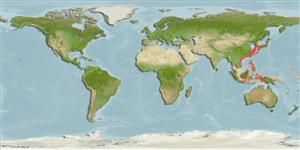Elasmobranchi (squali e razze) (sharks and rays) >
Carcharhiniformes (Ground sharks) >
Proscylliidae (Finback catsharks)
Etymology: Proscyllium: pro (L.), in front of, probably referring to far forward placement of dorsal fin compared with Scyllium (=Scyliorhinus, Scyliorhinidae). (See ETYFish); habereri: In honor of German physician, anthropologist and natural history collector Karl Albert Haberer (1864-1941), who collected holotype. (See ETYFish).
More on author: Hilgendorf.
Environment: milieu / climate zone / depth range / distribution range
Ecologia
marino demersale; distribuzione batimetrica 50 - 100 m (Ref. 244). Tropical; 39°N - 8°S
Western Pacific: southeastern Japan to Viet Nam and northwestern Java, Indonesia (Ref. 13566).
Size / Peso / Age
Maturity: Lm ? range ? - ? cm
Max length : 57.0 cm TL maschio/sesso non determinato; (Ref. 244); 65.0 cm TL (female)
Spine dorsali (totale): 0; Raggi dorsali molli (totale): 0; Spine anali 0; Raggi anali molli: 0. Caudal fin without a rippled dorsal margin and ventral lobe but with a strong subterminal notch; vertebral axis of caudal fin little raised above body axis (Ref. 13566). Round dark brown spots and indistinct saddles (Ref. 13566).
A little-known, uncommon bottom-dwelling shark found on the shelves of continental and insular waters (Ref. 244). Dwell on the sublittoral zone, 50-320 m (Ref. 11230). Food habits little known; probably feeding on bony fishes, crustaceans and cephalopods (Ref. 244). Oviparous (Ref. 50449), with 1 to 2 pups in a litter (Ref. 244).
Life cycle and mating behavior
Maturità | Riproduzione | Deposizione | Uova | Fecundity | Larve
Oviparous, with a single egg deposited per uterus (Ref. 244). Embryos feed solely on yolk (Ref. 50449).
Compagno, L.J.V., 1984. FAO Species Catalogue. Vol. 4. Sharks of the world. An annotated and illustrated catalogue of shark species known to date. Part 2 - Carcharhiniformes. FAO Fish. Synop. 125(4/2):251-655. Rome: FAO. (Ref. 244)
IUCN Red List Status (Ref. 130435)
Human uses
Pesca: pesca di sussistenza
Informazioni ulteriori
Age/SizeAccrescimentoLength-weightLength-lengthLength-frequenciesMorfometriaMorfologiaLarveDinamica popolazioni larvaliReclutamentoAbbondanzaBRUVS
BibliografiaAcquacolturaProfilo di acquacolturaVarietàGeneticaElectrophoresesEreditarietàMalattieElaborazioneNutrientsMass conversion
CollaboratoriImmaginiStamps, Coins Misc.SuoniCiguateraVelocitàModalità di nuotoArea branchialeOtolithsCervelliVista
Strumenti
Special reports
Download XML
Fonti Internet
Estimates based on models
Preferred temperature (Ref.
123201): 17.4 - 28, mean 25.1 °C (based on 134 cells).
Phylogenetic diversity index (Ref.
82804): PD
50 = 0.6328 [Uniqueness, from 0.5 = low to 2.0 = high].
Bayesian length-weight: a=0.00389 (0.00180 - 0.00842), b=3.12 (2.94 - 3.30), in cm total length, based on all LWR estimates for this body shape (Ref.
93245).
Trophic level (Ref.
69278): 4.1 ±0.57 se; based on food items.
Resilienza (Ref.
120179): Molto basso, tempo minimo di raddoppiamento della popolazione più di 14 anni (Fec = 1-2).
Fishing Vulnerability (Ref.
59153): Moderate to high vulnerability (46 of 100).
